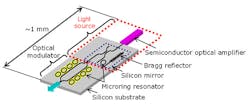Silicon photonics light source from Fujitsu shrinks transceivers and CPU interconnects
Kawasaki, Japan--A compact silicon photonics light source to be integrated in an optical transceiver has been developed by Fujitsu Laboratories Limited. The new design introduces mechanism that automatically keeps the wavelength of the light source and the operating wavelength of the optical modulator in sync, allowing the device to be smaller and more energy efficient. In addition to shrinking the size of communications transceiver components, these small light sources could be mounted directly in computer central processing units (CPUs) to create high-density optical interconnects between CPUs for exaflop-class supercomputers and high-speed, high-end servers.
The Fujitsu light source is comprised of a silicon mirror and a semiconductor optical amplifier. The silicon mirror is itself composed of a ring resonator and Bragg reflector that control the lasing wavelength. The sizes of the ring resonators introduced into both the light source and the optical modulator are exactly the same, so that shifts in the lasing wavelength of the light source and the modulator caused by CPU heating should match, eliminating the need for thermal control and reducing the transceiver footprint.
The transmitter component can be shrunk to less than 1 mm in length and an array of these components should be able to produce an optical transceiver for a large-capacity optical interconnect that is small enough to be mounted on a CPU module.
SOURCE: Fujitsu Laboratories; www.fujitsu.com/global/news/pr/archives/month/2011/20110916-01.html

Gail Overton | Senior Editor (2004-2020)
Gail has more than 30 years of engineering, marketing, product management, and editorial experience in the photonics and optical communications industry. Before joining the staff at Laser Focus World in 2004, she held many product management and product marketing roles in the fiber-optics industry, most notably at Hughes (El Segundo, CA), GTE Labs (Waltham, MA), Corning (Corning, NY), Photon Kinetics (Beaverton, OR), and Newport Corporation (Irvine, CA). During her marketing career, Gail published articles in WDM Solutions and Sensors magazine and traveled internationally to conduct product and sales training. Gail received her BS degree in physics, with an emphasis in optics, from San Diego State University in San Diego, CA in May 1986.
